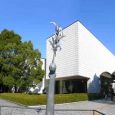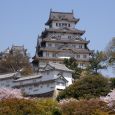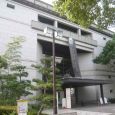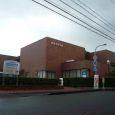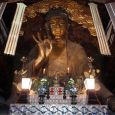Gifu
Advertisement
By plane
Chubu International Airport (NGO) is the nearest airport to Gifu. Meitetsu trains run directly from the airport to the Meitetsu Gifu station three times per hour at a cost of ¥1310 for an unreserved seat, or ¥1660 for a reserved seat; seat reservations are mandatory on the limited-stop trains. The trip takes about one hour.
By train
Gifu is a station on the JR Tokaido Main Line and JR Takayama Line. Frequent services on the Tokaido Line run to Gifu from Nagoya Station (18-25 minutes, ¥450). From Tokyo it takes approximately 2 1/4-2 1/2 hours via the Tokaido Shinkansen Nozomi service, changing at Nagoya (¥11000). The Nozomi is not covered by the Japan Rail Pass; Hikari services from Tokyo will slightly increase the travel time. From Kyoto and Osaka, it takes slightly over an hour to reach Gifu via Nozomi, changing in Nagoya (¥6100).
By bus
There are scheduled buses (5 times/day) connecting Osaka Namba OCAT to Shin Gifu Bus Center. The trip takes less than 3 hours under normal traffic condition.
Gifu Castle
Gifu Castle sits atop Mt. Kinka, and the main attraction is a 360-degree panoramic view from the top floor. The castle was historically significant as Oda Nobunaga used it as a headquarters when unifying Japan, however the castle was destroyed in 1601, after the Battle of Sekigahara. The current castle was completed in 1956 and underwent a major renovation in 1997. Inside the castle is a small museum with armor, swords, maps, etc. The castle is open for night viewing in the summer. Getting to the top of Mt. Kinka requires either a ropeway ride or a hike. Castle admission, ¥200
Mt. Kinka
Mt. Kinka is a 329-meter peak next to Gifu Park, with good views of the Nagara River and the city below. On top of Mt. Kinka is Gifu Castle, a small castle museum, and a "squirrel park". Most people will take the ropeway to the top. As an alternative, you can hike through the forest, taking either the shorter and steeper hyaku-magari ('100-bend') or the longer and gentler nana-magari ('7-bend') trail. Each will take over an hour, and good hiking footwear is recommended, especially on the "100-bend" (actually 135-bend) trail. The meiso no komichi trail is easier, with some steep sections, and is a popular school outing for local kindergartens while the uma no se trail is direct and more demanding. Ropeway round trip ¥1050, ¥520 children. Museum ¥200. Squirrel park ¥200.
Gifu City Museum of History
There are exhibition corners where you can experience history while being introduced to it. In particular, the Castle Town of the Warring States Period is displayed in-scale and the Rakuichi-ba has been restored. (Rakuichi-ba is the Free Market established by Oda Nobunaga for the promotion of the Castle Town economy by drawing in merchants.)
Kato Eizo-Toichi Memorial Art Museum
Kato Eizo-Toichi Memorial Art Museum was established in 1991 as a place to admire the well-known Japanese artists, Eizo and Toichi Kato, who were both born in Gifu. It houses paintings by the Kato brothers and holds a variety of exhibitions for the locals.
Nawa Insect Museum
The Nawa Insect Museum has been open since 1919 and is the oldest insect museum in Japan. In this museum, familiar insects, as well as rare and attractive species from all over the world, are exhibited. The museum also sells entomology tools and there are also talks about insects. Because the building is very important for historical value, the museum is a Registered Tangible Cultural Property.
Gifu Great Buddha
The Gifu Daibutsu (Great Statue of Buddha) is located southwest of Gifu Park in the Colossal Hall of the Great Buddha at Kinpo-san Shobo-ji Temple. It is basketwork-style, painted with lacquer, and plated gold. It is the largest Buddha statue of this type in Japan. The statue is 13.7 meters tall. The ears are 2.1 meters long and the nose is 0.4 meters wide. It contains an image of the Yakushi-nyorai made by Jikaku-daishi.
Sanko Art Museum
The Sanko Art Museum is located on a hill and affords a view of Mt. Kinka. It is in a quiet area surrounded by Sarastewartia trees (similar to camellias). Coffee, tea, and green tea are served here. The museum houses tea utensils and paintings, including those by Renoir, Chagall, and Ryuzaburo Umehara.
The Museum of Fine Arts, Gifu
The Museum of Fine Arts, Gifu has approximately 3,000 works, including the world-famous collection of Odilon Redon. It comprises broad fields, especially the local, modern, and contemporary artists. Temporary exhibitions are held periodically. In addition, you can enjoy our exhibition-related events; talks, lectures, workshops, performances, and so on. Also, there is the beautiful and peaceful garden of 20,000 trees and a stream.
Gifu City Science Museum
The Gifu City Children Science Museum was built in 1955. It was moved to its present location and called the Gifu City Children’s Science Center in 1980. The name was changed to the Gifu City Science Museum in 1988 when the planetarium was added. We have the planetarium and many exhibits that can be operated and touched. It’s an intellectual place to learn through experiences.
April - August


